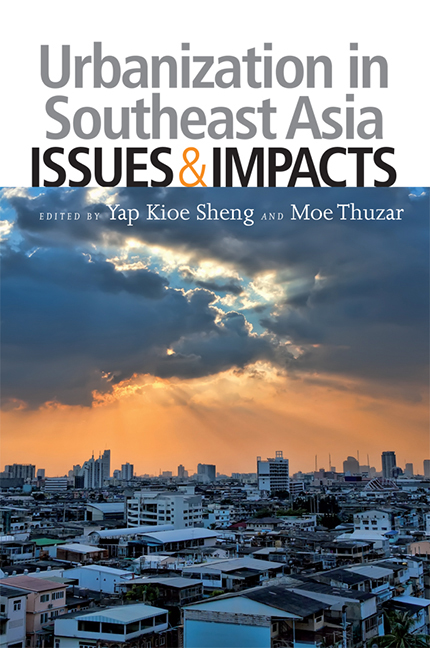Book contents
- Frontmatter
- Contents
- Message from Head, ASEAN Studies Centre
- Message from Director, Centre for Liveable Cities
- About the Contributors
- Introduction
- Urbanization in Southeast Asian Countries: Recommendations
- 1 The Challenges of Promoting Productive, Inclusive and Sustainable Urbanization
- Cities as Engines of Development
- Inclusive Cities
- Cities and the Environment
- 9 Climate Change and Southeast Asian Urbanization: Mitigation and Adaptation Considerations
- 10 Urban Green Spaces and Liveability in Southeast Asia
- 11 Decentralized Waste Water Management for the Waste Water Revolution in Urban Areas to Support the Engines of Development in Southeast Asia
- Governance, Decentralization, and Urbanization
- Urbanization from an ASEAN Perspective
- Index
9 - Climate Change and Southeast Asian Urbanization: Mitigation and Adaptation Considerations
from Cities and the Environment
Published online by Cambridge University Press: 21 October 2015
- Frontmatter
- Contents
- Message from Head, ASEAN Studies Centre
- Message from Director, Centre for Liveable Cities
- About the Contributors
- Introduction
- Urbanization in Southeast Asian Countries: Recommendations
- 1 The Challenges of Promoting Productive, Inclusive and Sustainable Urbanization
- Cities as Engines of Development
- Inclusive Cities
- Cities and the Environment
- 9 Climate Change and Southeast Asian Urbanization: Mitigation and Adaptation Considerations
- 10 Urban Green Spaces and Liveability in Southeast Asia
- 11 Decentralized Waste Water Management for the Waste Water Revolution in Urban Areas to Support the Engines of Development in Southeast Asia
- Governance, Decentralization, and Urbanization
- Urbanization from an ASEAN Perspective
- Index
Summary
Two major global processes dominating the twenty-first century are expanding urbanization and climate change. These combined events are likely to have colossal impacts on human activities globally and in Southeast Asia. Rapid urbanization has made cities the norm of human living worldwide. Globally the world's urban population lives in 408 cities of over one million people and twenty megacities of over ten million people; of the 408 cities, 377 cities are in the developing world, and Asia has 67 per cent (377 cities) of the global total (Flavin 2007, p. xxiii). Despite the fact that cities cover less than 1 per cent of the world's surface area, they accommodate over 50 per cent of the world's population, use 75 per cent of the world's energy, account for 78 per cent of carbon emissions, and are responsible for 75 per cent of greenhouse gases (Brown 2001, p. 188; World Wide Fund for Nature (WWF) 2009, p. 8).
There is a plethora of literature on global climate change which does not need repeating here (Flannery 2006; Dawson and Spannagle 2009; Touffut 2009; Posner and Weisbach 2010). Another endorsement of climate change is the recent idea of “planetary boundaries”, which are meant to define “the safe operating space for humanity with respect to the Earth system and are associated with the planet's biophysical subsystems or processes” (Rockström et al. 2009, p. 472). Based on nine Earth-system processes (climate change, rate of biodiversity loss — terrestrial and marine — interference with the nitrogen and phosphorous cycles, stratospheric ozone depletion, ocean acidification, global freshwater use, change in land use, chemical pollution, and atmospheric aerosol loading), this study found that three of the nine Earth-system processes, namely climate change, rate of biodiversity loss, and interference with the nitrogen cycles, “have already transgressed their boundaries” (Rockström et al. 2009, p. 473). Given these twin issues, this chapter aims to assess the adaptive and mitigation challenges Southeast Asian cities face with respect to climate change. Specifically, the chapter explores the urban policy options regionally and nationally.
- Type
- Chapter
- Information
- Urbanization in Southeast AsiaIssues and Impacts, pp. 229 - 261Publisher: ISEAS–Yusof Ishak InstitutePrint publication year: 2012



